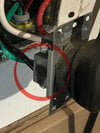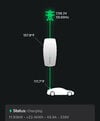Well, I am a hardware design engineer and had a career doing this and that with temperature sensors, fans, thermocouples, and all that. So, not that I've ever tried to disassemble a Tesla, I kinda know how these things go. I believe you about the RTD.
I dunno about that handle, though. It has the looks of Nothing Repairable By A Mere Human, what with all that heavy rubber and no fasteners visible, anywhere. I imagine that a determined individual with a sharp Xacto knife and No Cares Whatsoever if stuff gets sliced can get into one and see what can be seen. But the end result of that, even with a discovered and clean repair, still means that one has a handle with 240 VAC on it and.. maybe not such a great job of insulating the high voltage from a human. Especially if it gets rained upon.
Unless you had to send your TWC back to Tesla (I suppose they might want it, for FMA, but who knows?), you could do the Xacto knife trick, with the understanding that this is for curiosity's sake only, and you're Never Going To Apply Power To That Thing Again, darn it!
Besides, as I pointed out before - it might not be the handle that's faulty, but maybe corrosion or cold solder joints on the chip that measures the temperature. Oddly enough, I have had to contend with that particular failure case before. Dirty, these central offices can be.




